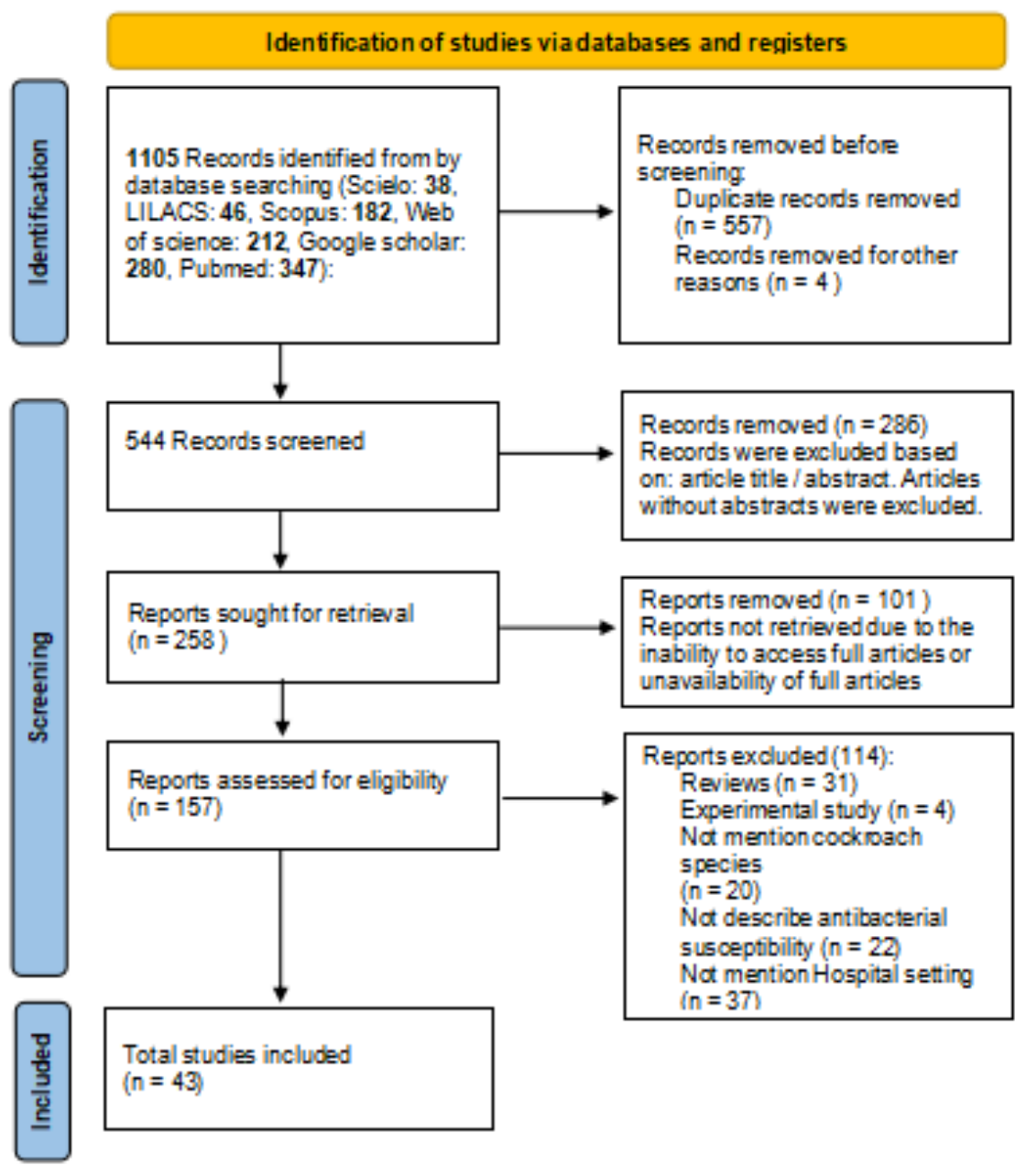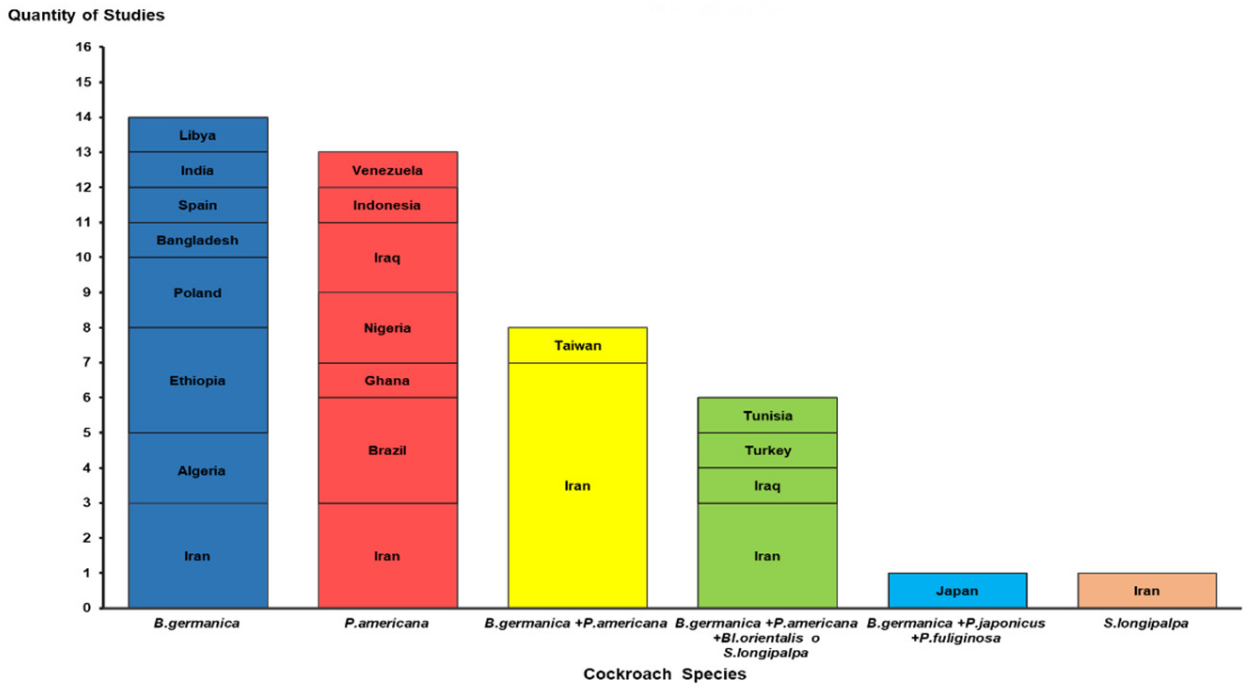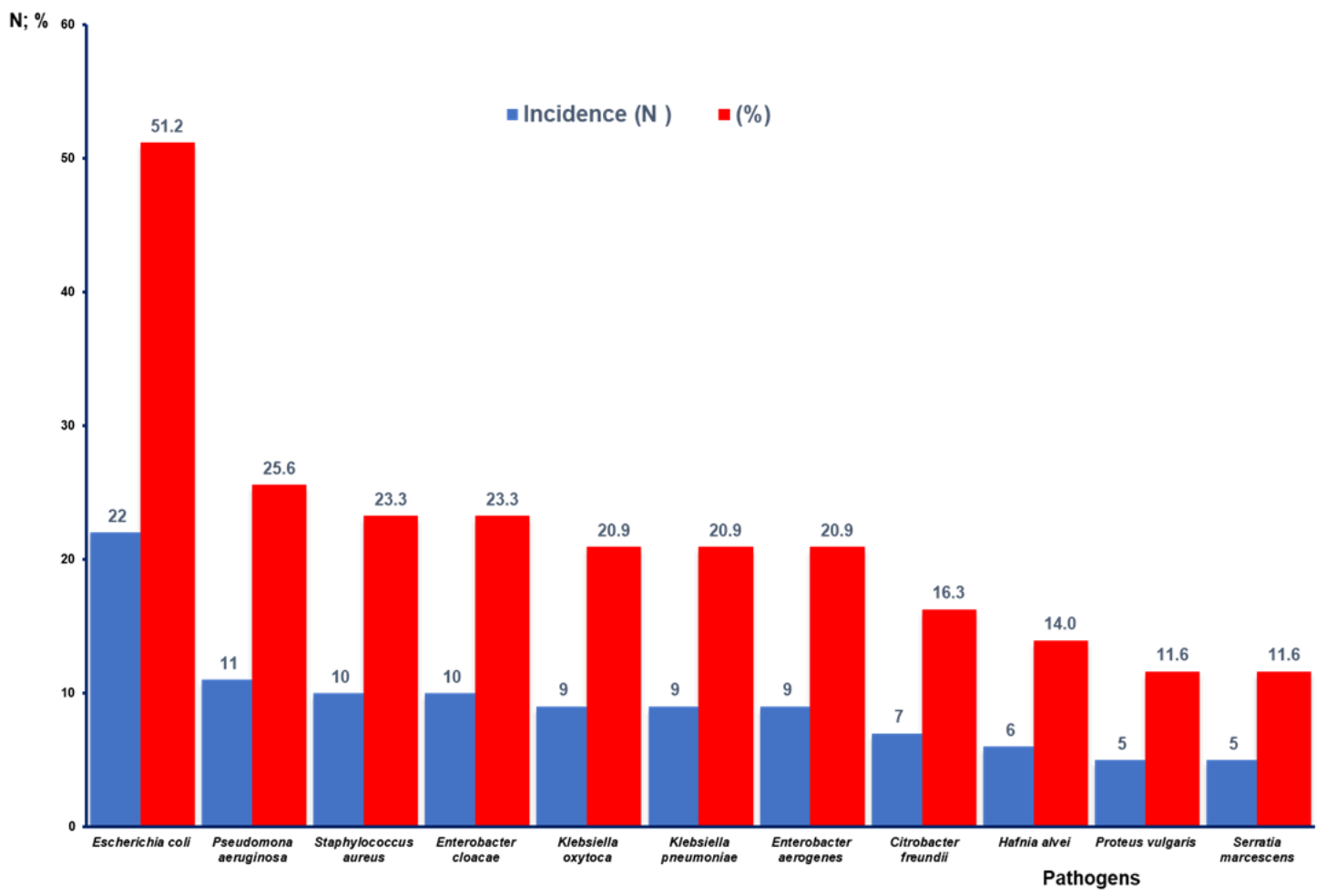Pathogens of Medical Importance Identified in Hospital-Collected Cockroaches: A Systematic Review
Abstract
1. Introduction
2. Materials and Methods
2.1. Design
2.2. Methodology Used in the Search for Relevant Studies
- The following keywords were established: cockroach, hospital, bacteria, fungi, parasites, pathogen transmission, virus, hospital-acquired infection, and antibiotic resistance. In order to optimize the retrieval of relevant information, the bibliographic citations of the articles examined were selected.
- The literature search was conducted using Google Scholar and electronic databases pertinent to the field of health, namely LILACS, the SciELO portal, Scopus, Web of Science, and PubMed. The time interval was from January 2000 to December 2024.
2.3. Inclusion Criteria for Studies
- Reports of isolation and identification of pathogenic organisms of medical importance from external or internal parts of cockroaches collected in hospital facilities.
- Articles that described susceptibility testing to antibiotics in bacteria.
- Articles published in the period from 1 January 2000 to 31 December 2024. For the establishment of this period of time, we took into account what was described by Guzman et al. [4] who express that since 2000 there has been an increase in publications in PubMed related to the topic of cockroaches and the pathogens identified from the bodies of these insects.
- Any scientific reports published in the form of a thesis, scientific article, or letter to the editor in English, Spanish, or Portuguese.
2.4. Exclusion Criteria for Studies
- Articles in which the scientific name of the cockroach species collected is absent.
- Publications that constitute review articles.
2.5. Statistical Analysis
- The GraphPad Prism v.10.1.2 software package (Boston, MA, USA) was used to present the results in figures.
3. Results
3.1. Search for Information
3.2. Distribution of Articles by Continent and Country
3.3. Cockroach Species Collected and Identified in the Studies Analyzed
3.4. Microorganisms Isolated and Identified from Cockroaches Collected in Hospitals
3.5. Antibiotic Resistance and Mechanisms of Resistance in Bacteria Identified in Cockroaches
3.6. Methods for Identification of Microorganisms and Antibiotic Resistance
4. Discussion
5. Conclusions
Supplementary Materials
Author Contributions
Funding
Conflicts of Interest
References
- Cochran, D.G.; World Health Organization, Communicable Diseases Prevention and Control and WHO Pesticide Evaluation Scheme. Cockroaches Their Biology, Distribution and Control. (WHOPES)WHO/CDS/CPC/WHOPES/99.3. 1999, pp. 1–83. Available online: https://iris.who.int/handle/10665/65846 (accessed on 4 May 2023).
- Tang, Q.; Vargo, E.L.; Ahmad, I.; Jiang, H.; Varadínová, Z.K.; Dovih, P.; Kim, D.; Bourguignon, T.; Booth, W.; Schal, C.; et al. Solving the 250-year-old mystery of the origin and global spread of the German cockroach, Blattella germanica. Proc. Natl. Acad. Sci. USA 2024, 121, e2401185121. [Google Scholar] [CrossRef] [PubMed]
- Atiokeng Tatan, R.J.; Tsila, H.G.; Wabo Poné, J. Medically Important Parasites Carried by Cockroaches in Melong Subdivision, Littoral, Cameroon. J. Parasitol. 2017, 2017, 7967325. [Google Scholar] [CrossRef] [PubMed]
- Guzman, J.; Vilcinskas, A. Bacteria associated with cockroaches: Health risk or biotechnological opportunity? Appl. Microbiol. Biotechnol. 2020, 104, 10369–10387. [Google Scholar] [CrossRef] [PubMed]
- Nasirian, H.; Salehzadeh, A. Control of Cockroaches (Blattaria) in Sewers: A Practical Approach Systematic Review. J. Med. Entomol. 2019, 56, 181–191. [Google Scholar] [CrossRef]
- Abdolmaleki, Z.; Mashak, Z.; Dehkordi, F.S. Phenotypic and genotypic characterization of antibiotic resistance in the methicillin-resistant Staphylococcus aureus strains isolated from hospital cockroaches. Antimicrob. Resist. Infect. Control 2019, 8, 54. [Google Scholar] [CrossRef]
- Donkor, E.S. Nosocomial Pathogens: An In-Depth Analysis of the Vectorial Potential of Cockroaches. Trop. Med. Infect. Dis. 2019, 4, 14. [Google Scholar] [CrossRef]
- Lemiech-Mirowska, E.; Kiersnowska, Z.M.; Michałkiewicz, M.; Depta, A.; Marczak, M. Nosocomial infections as one of the most important problems of the healthcare system. Ann. Agric. Environ. Med. 2021, 28, 361–366. [Google Scholar] [CrossRef]
- Hamu, H.; Debalke, S.; Zemene, E.; Birlie, B.; Mekonnen, Z.; Yewhalaw, D. Isolation of Intestinal Parasites of Public Health Importance from Cockroaches (Blattella germanica) in Jimma Town Southwestern Ethiopia. J. Parasitol. Res. 2014, 2014, 186240. [Google Scholar] [CrossRef]
- Adenusi, A.A.; Akinyemi, M.I.; Akinsanya, D. Domiciliary Cockroaches as Carriers of Human Intestinal Parasites in Lagos Metropolis, Southwest Nigeria: Implications for Public Health. J. Arthropod Borne Dis. 2018, 12, 141–151. [Google Scholar] [CrossRef]
- Fathpour, H.; Emtianzi, G.; Ghasemi, E. Cockroaches as Reservoir and Vector Drug Resistant Salmonella spp. Iran. Biomed. J. 2003, 7, 35–38. [Google Scholar]
- Prado, M.A.; Pimenta, F.C.; Hayashid, M.; Souza, P.R.; Pereira, M.S.; Gir, E. Enterobactérias isoladas de baratas (Periplaneta americana) capturadas em um hospital brasileiro. Panam. J. Public. Health 2002, 11, 93–98. [Google Scholar] [CrossRef] [PubMed][Green Version]
- Gliniewicz, A.; Czajka, E.; Laudy, A.E.; Kochman, M.; Grzegorzak, K.; Ziólkowsha, K.; Sawicka, B.; Stypulkowska-Misiurewicz, H.; Pancer, K. German Cockroaches (Blattella germanica L) as a Potential Source of Pathogens causing Nosocomial Infections. Indoor Built Envirom. 2003, 12, 55–60. [Google Scholar] [CrossRef]
- Elgderi, R.M.; Ghenghesh, K.S.; Berbash, N. Carriage by the German cockroach (Blattella germanica) of multiple–antibiotic-resistant bacteria that are potentially pathogenic to humans, in hospitals and households in Tripoli, Libya. Ann. Trop. Med. Parasitol. 2006, 100, 55–62. [Google Scholar] [CrossRef] [PubMed]
- Tilahun, B.; Worku, B.; Tachbele, E.; Terefe, S.; Kloos, H.; Legesse, W. High load of multi-drug resistant nosocomial neonatal pathogens carried by cockroaches in a neonatal intensive care unit at Tikur Anbessa specialized hospital, Addis Ababa, Ethiopia. Antimicrob. Resist. Infect. Control 2009, 1, 12. [Google Scholar] [CrossRef]
- Loucif, L.; Gacemi-Kirane, D.; Cherak, Z.; Chamlal, N.; Grainat, N.; Rolainb, J.-M. First Report of German Cockroaches (Blattella germanica) as Reservoirs of CTX-M-15 Extended-Spectrum--Lactamase- and OXA-48 Carbapenemase-Producing Enterobacteriaceae in Batna University Hospital, Algeri. Antimicrob. Agents Chemother. 2016, 60, 6377–6380. [Google Scholar] [CrossRef]
- Xia, J.; Gao, J.; Tang, W. Nosocomial infection and its molecular mechanisms of antibiotic resistance. Biosci. Trends 2016, 10, 14–21. [Google Scholar] [CrossRef]
- Saitou, K.; Furuhata, K.; Kawakami, Y.; Fukuyama, M. Isolation of Pseudomona aeruginosa from cockroaches captured in Hospitals in Japan, and their Antibiotic Susceptibility. Biocontrol Sci. 2009, 14, 155–159. [Google Scholar] [CrossRef][Green Version]
- Abdolmaleki1, Z.; Mashak, Z.; Safarpoor, F. Molecular and Virulence Characteristics of Methicillin-Resistant Staphylococcus aureus Bacteria Recovered from Hospital Cockroaches. Jundishapur J. Microbiol. 2019, 12, e98564. [Google Scholar] [CrossRef]
- Chehelgerdi, M.; Reza Ranjbar, R. Virulence factors and antibiotic resistance properties of Streptococcus species isolated from hospital cockroaches. Biotech 2021, 11, 321. [Google Scholar] [CrossRef]
- Page, M.J.; McKenzie, J.E.; Bossuyt, P.M.; Boutron, I.; Hoffmann, T.C.; Mulrow, C.D.; Shamseer, L.; Tetzlaff, J.M.; Akl, E.A.; Brennan, S.E.; et al. The PRISMA 2020 statement: An updated guideline for reporting systematic reviews. BMJ 2021, 372, n71. [Google Scholar] [CrossRef]
- Pai, H.-H.; Chen, W.-C.; Peng, C.-F. Cockroaches as Potential Vectors of Nosocomial Infections. Infect. Control Hosp. Epidemiol. 2004, 25, 979–984. [Google Scholar] [CrossRef] [PubMed]
- Tachbele, E. Cockroach-Associated Food-Borne Bacterial Pathogens from Some Hospitals and Food Handling Establishment in Addis Ababa. Master’s Thesis, Addis Ababa University, Addis Ababa, Ethiopia, 2004. Available online: https://www.academia.edu/75878702 (accessed on 17 December 2024).
- Prado, M.A.; Gir, E.; Pereira, M.S.; Reis, C.; Pimienta, F.C. Profile of Antimicrobial Resistance of Bacteria Isolated from Cockroaches (Periplaneta americana) in a Brazilian Health Care Institution. Braz. J. Infect. Dis. 2006, 10, 26–32. [Google Scholar] [CrossRef] [PubMed][Green Version]
- Tachbele, E.; Erku, W.; Gebre-Michael, T.; Ashenafi, M. Cockroach-associated food-borne bacterial pathogens from some hospitals and restaurants in Addis Ababa, Ethiopia: Distribution and antibiograms. J. Rural Trop. Public Health 2006, 5, 34–41. [Google Scholar]
- Pancer, K.; Gut, W.; Fila, S.; Trzcinska, A.; Roszkowiak, A.; Laudy, A.E.; Wernik, T.; Mikulak, E.; Gliniewicz, A.; Stypulkowska-Misiurewicz, H. Strains of Enterobacter cloacae Isolated in a Hospital Environment—Some Phenotypic and Genotypic Properties. Indoor Built Environ. 2006, 15, 99–104. [Google Scholar] [CrossRef]
- Salehzadeh, A.; Tavacolb, P.; Mahjub, H. Bacterial, fungal and parasitic contamination of cockroaches in public hospitals of Hamadan, Iran. J. Vector Borne Dis. 2007, 44, 105–110. [Google Scholar]
- Miranda, R.A.; Silva, J.P. Enterobactérias isoladas de Periplaneta americana capturadas em um ambiente hospitalar. Ciência Prax. 2008, 1, 21–24. [Google Scholar]
- Tetteh-Quarcoo, P.B.; Donkor, E.S.; Attah, S.K.; Duedu, K.O.; Afutu, E.; Boamah, I.; Olu-Taiwo, M.; Anim-Baidoo, I.; Ayeh-Kumi, P.F. Microbial carriage of cockroaches at a tertiary care hospital in Ghana. Environ. Health Insights 2013, 7, 59–66. [Google Scholar] [CrossRef]
- Motevalli-Haghi, S.F.; Aghili, S.R.; Gholami, S.; Salmanian, B.; Nikokar, S.H.; Khangolzadeh, M.; Geravi, H. Isolation of medically important fungi from cockroaches trapped at hospitals of Sari, Iran. Bull. Environ. Pharmacol. Life Sci. 2014, 3, 29–36. [Google Scholar]
- Reza, M.; Shahriari-Namadi, M.; Moemenbellah-Fard, M.D.; Reza, G.; Azizi, K.; Amin, M.; Motevasel, M. Antibiotics susceptibility patterns of bacteria isolated from American and German cockroaches as potential vectors of microbial pathogens in hospitals. Asian Pac. J. Trop. Dis. 2014, 4, 790–794. [Google Scholar] [CrossRef]
- Suresh, K.; Mathiyazhagan, N.; Selvam, R. Cockroach-associated food-borne bacterial pathogens from some hospitals and restaurants in Hosur, Tamilnadu: Distribution and antibiograms. Mesop. Environ. J. 2015, 2, 87–99. [Google Scholar]
- Cazorla, D.; Morales, P.; Navas, P. Aislamiento de parásitos intestinales en la cucaracha americana (Periplaneta americana) en Coro, estado Falcón, Venezuela. Boletín Malariol. Salud Ambient. 2015, 55, 184–193. [Google Scholar]
- Jabber, A.S.; Hamim, S.S.; Ali, S.T.; Abid, I.N. Gram-negative bacteria load and multiple antibiotic resistance (mar) pattern of pathogenic bacteria isolated from cockroaches at haboubi hospital in the province of Dhi—Qar. World J. Pharm. Res. 2015, 4, 193–204. [Google Scholar]
- Ikechukwu, O.; Ifeanyichukwu, I.; Chika, E.; Okapi, E.; Ogbonnaya, O. Cockroaches (Periplaneta americana) as possible reservoirs of extended spectrum beta-lactamase (ESBL)-producing pathogenic bacteria. Int. J. Res. Biosci. 2017, 6, 41–49. [Google Scholar]
- Loucif, L.; Cherak, Z.; Chamlal, N.; Bendjama, E.; Gacemi-Kirane, D.; Grainat, N.; Rolainb, J.-M. First detection of VIM-2 metallo-β-lactamase-producing Pseudomonas putida in hospital cockroaches of the Blattella germanica species, Algeria. Antimicrob. Agents Chemother. 2017, 61, e00357-17. [Google Scholar] [CrossRef] [PubMed]
- Martínez-Girón, R.; Martínez-Torre, C.; Cornelis van Woerden, H.C. The prevalence of protozoa in the gut of German cockroaches (Blattella germanica) with special reference to Lophomonas blattarum. Parasitol. Res. 2017, 116, 3205–3210. [Google Scholar] [CrossRef]
- Al-Marjani, M.F.; Abdulrazaq, R.A.; Khadam, Z.A.; Daham, R.I.; Khiaria, J.; Tothli, K.J. Cockroaches (Periplaneta americana): Reservoirs of metallo β lactamase and extended spectrum β-lactamase producing bacteria in medical city hospital in Baghdad, Iraq. Pak. J. Biotechnol. 2017, 14, 317–321. [Google Scholar]
- Naher, A.; Afroz, S.; Hamid, S. Cockroach Associated Foodborne Pathogens: Distribution and Antibiogram. Bangladesh Med. Res. Counc. Bull. 2018, 44, 30–38. [Google Scholar] [CrossRef]
- Astiti, P.M.A.; Bialangi, M.; Kundera, I.N. Identification of bacteria on Cockroach feet from Hospital area in Palu city and test of sensitivity to antibiotic. IOP Conf. Ser. Mater. Sci. Eng. 2018, 434, 012123. [Google Scholar] [CrossRef]
- Nazari, S.; Habibi, F.; Nazari, S.; Hosseini, S.M.; Nazari, M. Bacterial contamination of external surface of cockroaches and their antibiotic resistance in hospitals of Hamadan, Iran. J. Postgrad. Med. Inst. 2020, 34, 104–109. [Google Scholar]
- Khodabandeh, M.; Shirani-Bidabadi, L.; Madani, M.; Zahraei-Ramazani, A. Study on Periplaneta americana (Blattodea: Blattidae) Fungal Infections in Hospital Sewer System, Esfahan City, Iran, 2017. J. Pathog. 2020, 2020, 4296720. [Google Scholar] [CrossRef]
- Montevalli-Haghi, F.S.; Shemshadian, A.; Nakhaei, M.; Faridnia, R.; Dehghan, O.; Shafaroudi, M.M. First report of Lophomonas spp. in German cockroaches (Blattella germanica) trapped in hospitals, northern Iran. J. Parasit. Dis. 2021, 45, 937–943. [Google Scholar] [CrossRef] [PubMed]
- Adegoke, A.A.; Okon, M.U.; Monday, E. Phenotypic Characterization and Antibiotic Susceptibility Profile of Coagulase Positive Staphylococci from The External Surfaces of Hospital Cockroaches (Periplaneta americana). Afr. J. Biomed. Res. 2021, 24, 197–201. [Google Scholar]
- Fotouhi-Ardakani, R.; Kababian, M.; Saghafipour, A.; Alirezaei, M.; Vatandoost, H. Molecular Evaluation of the Novel Coronavirus Infection of Cockroaches and Flies Collected from Kamkar-Arabnia Hospital in Qom City, Central Iran: With Innovated Internal Control. J. Arthropod-Borne Dis. 2021, 15, 358–365. [Google Scholar] [CrossRef] [PubMed]
- Landolsi, S.; Selmi, R.; Hadjadj, L.; Haj, A.B.; Romdhane, K.B.; Messadi, L.; Rolain, J.M. First Report of Extended-Spectrum b-Lactamase (blaCTX-M1) and Colistin Resistance Gene mcr-1 in E. coli of Lineage ST648 from Cockroaches in Tunisia. Microbiol. Spectr. 2022, 10, e0003621. [Google Scholar] [CrossRef]
- Seyfi, B.; Hossainpour, H.; Kooti, S.; Jalilian, F.A. Identification of Carbapenem Resistance Genes in Escherichia coli Isolated from Blattella germanica by Dot Blot Assay in Hamadan Hospitals, Iran—2018. Iran. J. Med Microbiol. 2022, 16, 357–362. [Google Scholar] [CrossRef]
- Turki, A.; Ali, M.; Merza, M.S.; Al-Ameer, L.R.; Alsandook, T. Bacterial contamination of cockroaches in different wards of hospital, restaurant and home. Heliyon 2023, 9, e22103. [Google Scholar] [CrossRef]
- Kalantari, M.; Vahedi, M.; Azizi, K.; Hosseinpour, A.; Jamalidoust, M.; Rezanezhad, H. First molecular detection of SARS-CoV-2 virus in cockroaches. Biologia 2023, 78, 1153–1160. [Google Scholar] [CrossRef]
- Madania, M.; Safaria, F.; Khodabandeha, M.; Izadib, S.; Zahraei-Ramazani, A. Periplaneta americana (Blattodea: Blattidae) fungal pathogens in hospital sewer systems: Molecular and phylogenetic approaches. J. Water Health 2023, 21, 643–652. [Google Scholar] [CrossRef]
- Davari, B.; Hassanvand, A.E.; Salehzadeh, A.; Alikhani, M.Y.; Hosseini, S.M. Bacterial Contamination of Collected Cockroaches and Determination their Antibiotic Susceptibility in Khorramabad City, Iran. J. Arthropod Borne Dis. 2023, 17, 63–71. [Google Scholar] [CrossRef]
- Veysi, A.; Kababian, M.; Gholi, M.K.; Godini, K.; Vatandoos, H.; Saghafipour, A. Comparing the Bacterial Flora of Insectary and Filed Strains of Supella longipalpa (Blattaria: Ectobiidae) and Their Antibiotic-Resistant Pattern in Qom Province, Central Iran. J. Arthropod-Borne Dis. 2023, 17, 197–205. [Google Scholar] [CrossRef]
- Cevahir, F.; Düzlü, Ö.; Atelge, M.; Yıldırım, A. Phylogenetic characterization of Cochroaches (Insecta: Blattaria) in Türkiye and determination of their vector potential for medically important parasites. Ank. Üniversitesi Vet. Fakültesi Derg. 2024, 71, 417–426. [Google Scholar] [CrossRef]
- Saberi, Y.; Halaji, H.; Karami, M.; Jafarzadeh, J.; Javadi, K.; Shirafkan, H.; Pournajaf, A. Antimicrobials profiling, biofilm formation, and clonal lineage of methicillin-resistant Staphylococcus aureus isolated from cockroaches. Heliyon 2025, 11, e41698. [Google Scholar] [CrossRef] [PubMed]
- Darby, E.M.; Trampari, E.; Siasat, P.; Solsona Gaya, M.; Alav, I.; Webber, M.A.; Blair, J.M. Molecular mechanisms of antibiotic resistance revisited. Nat. Rev. Microbiol. 2023, 21, 280–295. [Google Scholar] [CrossRef] [PubMed]
- Molewa, M.L.; Barnard, T.; Naicker, N. A potential role of cockroaches in the transmission of pathogenic bacteria with antibiotic resistance: A scoping review. J. Infect. Dev. Ctries. 2022, 16, 1671–1678. [Google Scholar] [CrossRef] [PubMed]
- Patel, A.; Jenkins, M.; Rhoden, K.; Barnes, A.N. A Systematic Review of Zoonotic Enteric Parasites Carried by Flies, Cockroaches, and Dung Beetles. Pathogens 2022, 11, 90. [Google Scholar] [CrossRef]
- Country Classification. Data Sources, Country Classifications and Aggregation Methodology. Available online: https://www.un.org/development/desa/dpad/wp-content/uploads/sites/45/WESP2019_BOOK-ANNEX-en.pdf (accessed on 25 May 2023).
- Le Guyader, A.; Rivault, C.; Chaperon, J. Microbial organisms carried by brown banded cockroaches in relation to their spatial distribution in a hospital. Epidemiol. Infect. 1989, 102, 485–492. [Google Scholar] [CrossRef]
- Kumar, D.; Chaudhary, M.; Midha, N.K.; Bohra, G.K.; Meena, D.S.; Tak, V.; Rathore, H.; Rathore, V.; Vaishnavi, M.H.; Tr, N.; et al. Pathogenic Burden, Antimicrobial Resistance Pattern and Clinical Outcome of Nosocomial Bloodstream Infections in Intensive Care Unit. J. Intensiv. Care Med. 2024, 8850666241305043. [Google Scholar] [CrossRef]
- Azzam, A.; Khaled, H.; Samer, D.; Nageeb, W.M. Prevalence and molecular characterization of ESBL-producing Enterobacteriaceae in Egypt: A systematic review and meta-analysis of hospital and community-acquired infections. Antimicrob. Resist. Infect. Control 2024, 13, 145. [Google Scholar] [CrossRef]
- Dantas, L.F.; Peres, I.T.; Antunes, B.B.P.; Bastos, L.S.L.; Hamacher, S.; Kurtz, P.; Martin-Loeches, I.; Bozza, F.A. Prediction of multidrug-resistant bacteria (MDR) hospital-acquired infection (HAI) and colonisation: A systematic review. Infect. Dis. Health 2025, 30, 50–60. [Google Scholar] [CrossRef]
- Mewara, A.; Gile, G.H.; Mathison, B.; Zhao, H.; Pritt, B.; Bradbury, R.S. Lophomonas as a respiratory pathogen-jumping the gun. J. Clin. Microbiol. 2024, 62, e0084523. [Google Scholar] [CrossRef]
- Merad, Y.; Belkacemi, M.; Merad, Z.; Bassaid, A.; Benmansour, Z.; Matmour, D.; Belmokhtar, Z. Fungal carriage of hospital trapped cockroaches: A prospective study. New Microbes New Infect. 2023, 52, 101086. [Google Scholar] [CrossRef]
- Kyu, H.H.; Vongpradith, A.; Dominguez, R.M.V.; Ma, J.; Albertson, S.B.; Novotney, A.; Khalil, I.A.; Troeger, C.E.; Doxey, M.C.; Ledesma, J.R. Global, regional, and national age-sex-specific burden of diarrhoeal diseases, their risk factors, and aetiologies, 1990–2021, for 204 countries and territories: A systematic analysis for the Global Burden of Disease Study 2021. Lancet Infect. Dis. 2024. [Google Scholar] [CrossRef]



Disclaimer/Publisher’s Note: The statements, opinions and data contained in all publications are solely those of the individual author(s) and contributor(s) and not of MDPI and/or the editor(s). MDPI and/or the editor(s) disclaim responsibility for any injury to people or property resulting from any ideas, methods, instructions or products referred to in the content. |
© 2025 by the authors. Licensee MDPI, Basel, Switzerland. This article is an open access article distributed under the terms and conditions of the Creative Commons Attribution (CC BY) license (https://creativecommons.org/licenses/by/4.0/).
Share and Cite
Crespo, A.; de Armas, Y.; Capó, V.; Iglesias, E.; Palomares-Marín, J.; Fonte, L.; Plascencia-Hernández, A.; Cueto-Aragón, C.L.; Calderón, E.J.; Pérez-Gómez, H.R. Pathogens of Medical Importance Identified in Hospital-Collected Cockroaches: A Systematic Review. Microorganisms 2025, 13, 337. https://doi.org/10.3390/microorganisms13020337
Crespo A, de Armas Y, Capó V, Iglesias E, Palomares-Marín J, Fonte L, Plascencia-Hernández A, Cueto-Aragón CL, Calderón EJ, Pérez-Gómez HR. Pathogens of Medical Importance Identified in Hospital-Collected Cockroaches: A Systematic Review. Microorganisms. 2025; 13(2):337. https://doi.org/10.3390/microorganisms13020337
Chicago/Turabian StyleCrespo, Ariel, Yaxsier de Armas, Virginia Capó, Enrique Iglesias, Jaime Palomares-Marín, Luis Fonte, Arturo Plascencia-Hernández, Claudia L. Cueto-Aragón, Enrique J. Calderón, and Héctor R. Pérez-Gómez. 2025. "Pathogens of Medical Importance Identified in Hospital-Collected Cockroaches: A Systematic Review" Microorganisms 13, no. 2: 337. https://doi.org/10.3390/microorganisms13020337
APA StyleCrespo, A., de Armas, Y., Capó, V., Iglesias, E., Palomares-Marín, J., Fonte, L., Plascencia-Hernández, A., Cueto-Aragón, C. L., Calderón, E. J., & Pérez-Gómez, H. R. (2025). Pathogens of Medical Importance Identified in Hospital-Collected Cockroaches: A Systematic Review. Microorganisms, 13(2), 337. https://doi.org/10.3390/microorganisms13020337








